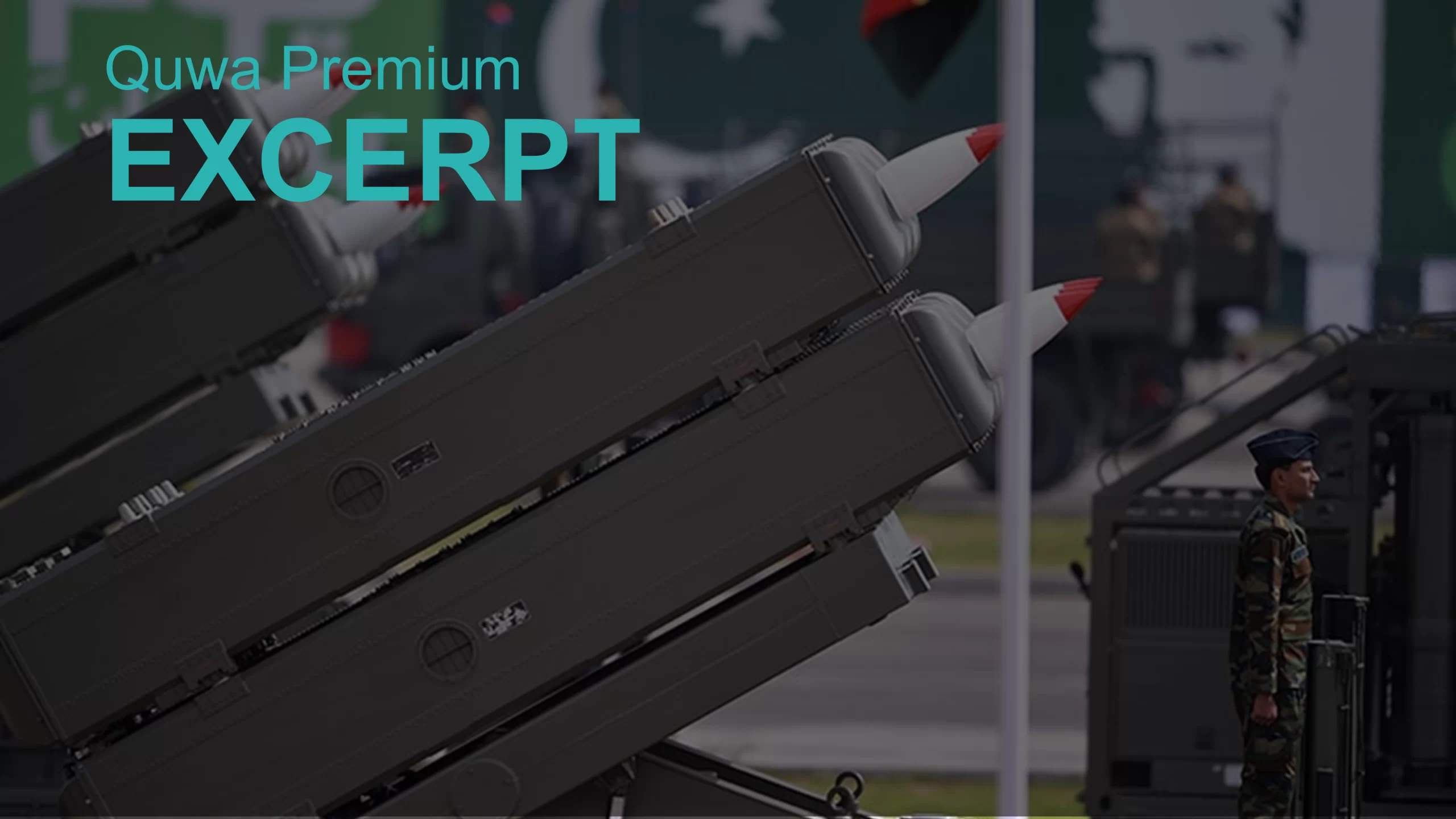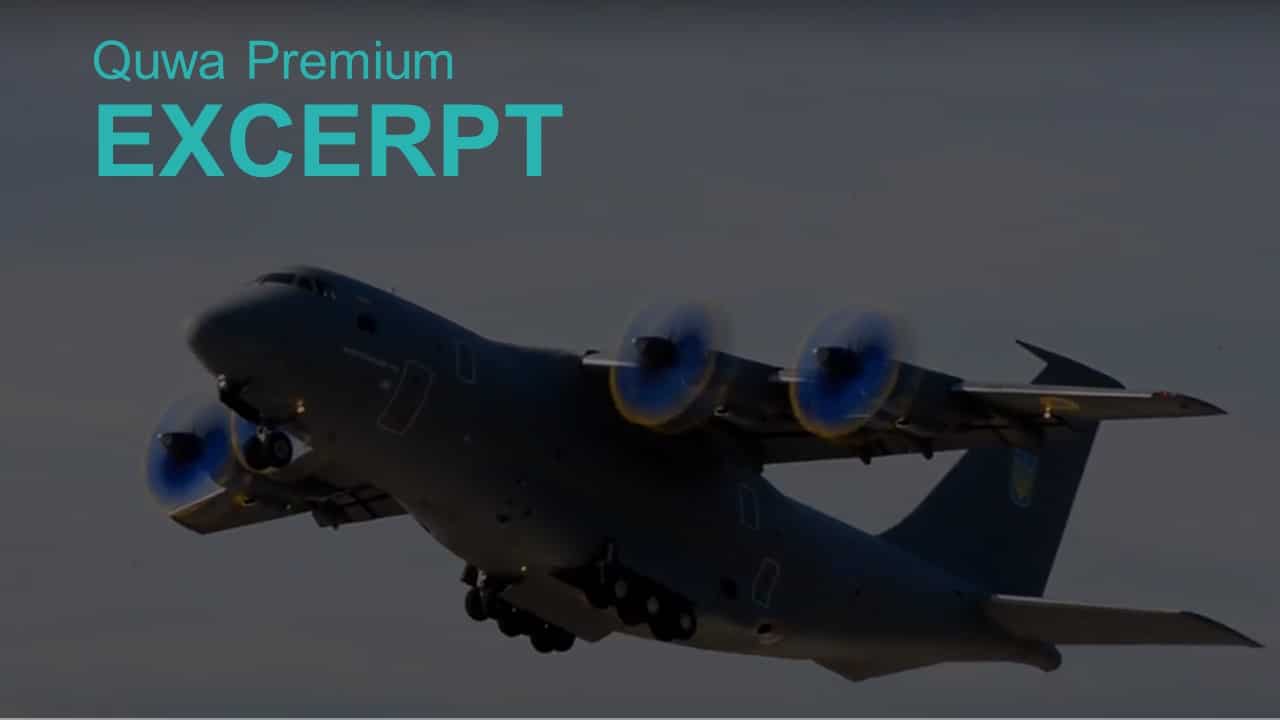6294Views

Pakistan Air Force Air Defence Development
Quwa Team
The following article is a section from an upcoming quarterly report on the Pakistan Air Force’s (PAF) modernization plans, which will be available to Quwa Premium subscribers on 29 March 2024.
In 2019, the Pakistan Air Force (PAF) had largely leaned on its fighter fleet to deny enemy aircraft access and control of its airspace. Surface-to-air missiles (SAM) did not figure much in the PAF’s approach, especially as its longest-range ‘vector’ at the time was the MBDA Spada 2000-Plus, which had a range of 20 km.
PAF mostly used its SAMs to protect installations, not deny – much less deter – enemy air activity near or across the national border. While it continued investing heavily in fighters since 2019, the PAF also revealed that it built a new and robust ground-based air defence system (GBADS). Air Headquarters (AHQ) likely appreciated Ukraine’s deft use of GBADS as a way of mitigating enemy air power over one’s territory and, in turn, adopted the idea to defend Pakistani airspace.
However, it is worth noting that in addition to medium- and long-range SAMs, the PAF also set the groundwork for leveraging directed energy weapons and passive air defence measures. This was likely done to address the threat of loitering munitions and swarming drones.
Surface-to-Air Missiles (SAM)
The PAF is no longer relying on only fighter aircraft for area denial; rather, SAMs will help improve its first-response mechanism against enemy air activity. To this end, the PAF has begun investing in both medium-to-long-range SAMs and long-range SAMs.
Until recent years, the PAF’s primary SAM solutions were the MBDA Spada 2000-Plus, French Crotale 2000, and Mistral man-portable air defence systems (MANPADS). Traditionally, the PAF’s GBADS was not built for territorial defence, but point-defence over installations, like air bases and radar sites.
Now, however, the PAF considers its GBADS a crucial asset for territorial defence, one meant to work in close concert with its fighter fleet. The new PAF GBADS is a multi-layered system made up of long-range, medium-range, and short-range SAMs plus other active and passive anti-air systems, such as directed energy weapons (DEW) and electronic attack (EA) systems.
HQ-9BE
In its promotional video, the PAF confirmed that it inducted the HQ-9BE, a long-range SAM system. It can intercept a variety of target types, including:
- Combat aircraft at a range of up to 260 km and altitude of 27 km
- Air-to-ground missiles (AGM) at a range of up to 50 km and altitude of 18 km
- Cruise missiles at a range of up to 25 km and altitude greater than 0.02 km
- Tactical ballistic missiles (TBM) at a range of up to 25 km and altitude of 18 km
The HQ-9BE missile’s guidance suite uses an inertial navigation system (INS) aided by a land-based targeting radar via datalink and a terminal-stage active radar-homing (ARH) seeker.
Unlike the older HT-XXX series of guidance radars found on the FD-2000, the HQ-9BE uses the JSG-400 TDR guidance radar, which is designed for TBM interceptions, and the JPG-600 TDR surveillance radar. Furthermore, the battery utilizes a command-and-control (C2) system and electronic counter-countermeasures (ECCM) system, plus several decoy vehicles.
The HQ-9BE is marketed as a limited theater air defence solution that could intercept fighter aircraft and long-range munitions. China Aerospace Science and Industry Corporation (CASIC) says that the HQ-9BE can intercept TBMs with ranges of up to 1,000 km. The HQ-9BE can respond against TBMs in 10 seconds and non-TBMs within 15 seconds. It is basically the PAF’s most advanced SAM system.
The PAF specifically highlighted counter-TBM and counter-cruise missile capabilities. While this was likely in reference to the HQ-9BE, it may indicate that the PAF is interested in the idea of building anti-ballistic missile (ABM) capabilities in the long-term. The HQ-9BE could be the starting point.
HQ-16FE
In addition to the HQ-9BE, the PAF also revealed that it acquired the Chinese HQ-16FE, which is also designated as the LY-80B. This is a vastly improved variant of the LY-80 already in service with the Pakistan Army and the Pakistan Navy. The HQ-16FE seems to form the PAF’s medium-to-long-range air defence layer.
The HQ-19FE offers a range of 25 km to 160 km with a minimum/maximum intercept altitude of 15 m to 27 km against fighter-sized targets. It leverages a datalink-aided INS guidance system as well as a dual-mode semi-active and active-radar homing (SARH/ARH) seeker. The HQ-16FE’s main guidance radar is a 2D active-scanning phased-array system with a range of 250 km against “normal” fighter-sized targets, likely in reference to a radar cross-section (RCS) of 5m2. It can simultaneously track 12 targets and engage 8 at once.
Like it had with the HQ-9BE, the PAF acquired the HQ-16FE to give itself another area-denial system in addition to its fighter fleet. By acquiring both systems, the PAF is building a densely layered GBADS that provides defensibility against fighters and munitions alike.
The PAF likely wants to emulate the impact Ukraine is seeing through its use of SAMs against Russian air power. For the PAF, SAMs may offer a quick-response mechanism against incoming enemy aircraft and, if successful, a means to deprecate an offensive attack before friendly fighters are in the air.
Spada 2000-Plus and its Conversion to Spada CIWS
The MBDA Spada 2000-Plus will likely soldier on. The PAF operates 10 batteries, which it ordered in 2007 from Italy for $475 million US. The Spada 2000-Plus uses a SARH seeker in conjunction with the Falco-Plus fire control radar (FCR) and RAC-3D radar. The PAF will likely continue using them to defend its air bases and other installations, perhaps as a short-range/point-defence system.
Interestingly, at the 2022 International Defence Exhibition and Seminar (IDEAS), the PAF indicated it would upgrade its Spada batteries by turning them into a close-in-weapons-system (CIWS) by adding anti-air guns (AAG). In its recent ceremonies at the National Aerospace Science and Technology Park (NASTP), the PAF showcased several potential iterations of this Spada CIWS concept.
The first model involves one Falco-Plus FCR and C2 suite mounted to a 6×6 truck, a six-cell Aspide-2000 missile launcher mounted to a 6×6 truck, and a rear-mounted Oerlikon GDF 35 mm AAG. It was complemented with an RAC-3D radar for surveillance and situational awareness.
An alternative model was also shown at NASTP. This system adopts the same configuration as above, but with one major difference with Pakistani sensors in place of the Falco-Plus FCR and RAC-3D.
Interestingly, a Pakistani state-owned entity is working on a ‘LOMADS’ SAM system with a range of 7 km to 100 km. With the HQ-9BE and HQ-16FE in service, the PAF would be in no rush to acquire such a system. However, if it materializes, this in-house LOMADS join the Spada 2000-Plus as the PAF’s lower-ranged complement to the HQ-16FE in the medium-range layer.
Crotale
The PAF has been a longstanding operator of the Thales Crotale, and it currently fields both legacy variants – the Crotale 2000 and Crotale 4000. Though aged, the PAF considers them effective, hence it intends to upgrade the Crotale 4000. Its upgrade plans for the Crotale 4000 involve two phases: an upgrade of the Crotale’s ACU (Acquisition Unit) – i.e., radar – and an upgrade of the FU (Firing Unit) as well as its missiles. Plans for these upgrades were showcased at IDEAS 2022 and at NASTP.
The modernized ACU apparently leverages a modern 4×4 Hino truck. The radar is to be mounted to a retractable mast. The electronics will be redesigned and enclosed in a modern cabin. The ACU would use new solid-state receivers, giving the ACU greater range.
SHORADS
The PAF has long relied on its Mistral MANPADS as its last line of defence. However, the PAF has been looking as of late to upgrade its SHORAD capabilities. For example, it acquired FN-16 MANPADS.
CIWS
Footage from the PAF’s promotional video also shows a system called ‘CIWS’ (typically short for the term, ‘close-in-weapons-system’). In addition to the Spada CIWS concept, the PAF is also interested in procuring one of the Chinese Type 730 or Type 1130 system.
It is worth seeing how the PAF further develops its point-defence capabilities in the coming years. It has an overt focus on intercepting munitions, such as cruise missiles. This focus could push the PAF to invest in dedicated solutions, like Counter-Rocket, Artillery, and Mortar (C-RAM) or point-defence missile systems (PDMS). The PAF has several C-RAM and PDMS options available on the market, like the Denel Cheetah, Emirati EDGE Group SkyKnight, and Turkish Aselsan Levent. These C-RAM/PDMS systems could form the PAF’s inner-layer coverage of its wider air defence environment.
Electronic Warfare
For the PAF, electronic warfare (EW) was traditionally an essential part of its offensive operations; but it is now leveraging EW for area denial. In its promotional video, the PAF highlighted at least three new land-based EW systems: HISAR-1, MIGAES, and EADS…
End of Excerpt (1,449/2,257 words)
You can read the complete article by logging in (click here) or subscribing to Quwa Premium (click here).
For more insights on the Pakistan Air Force:


